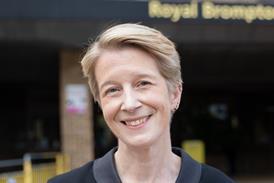Generating grassroots enthusiasm for change is vital to pave the way for more healthcare IT projects, writes Angharad-Grace Davis

When Jeremy Hunt challenged the NHS to be paperless by 2018, he made clear his role was to set the target, not deliver it. Ministers wanted to end the days of centrally driven IT projects, unleashing locally led innovation. In devolving responsibility for IT projects, the health secretary has potentially liberated a generation of junior doctors to help lead them.
This is already happening at Barts Health Trust in east London, where junior doctors are helping to transform the quality of care. The model offers an insight into the future of NHS IT, as well as some important lessons for would-be innovators.
Technology is embedded into our work and play. We use it to study, stream films, purchase groceries and plan our travel. Using it professionally to benefit patients therefore seems a no-brainer.
Paper problems
Younger clinicians benefit from not being wedded to the status quo. In fact, traditional methods often seem counterintuitive. On appointment as a neurology clinical fellow, I was dismayed to find a dependency on paper was not only reducing efficiency, but compromising patient safety.
The referral system involved so much paper that referrals were often lost, patients’ results were often not followed up and plans for review post-discharge not made. The case for change was obvious.
‘Junior doctors, with their instinctive understanding of the value of technology and enthusiasm for change, are natural technology champions’
Junior doctors were asked to design a paper-free system to address the problem. Using Cerner Millennium and the PowerChart function, we created a system that allowed referring clinicians to track patients and launched a pathway to streamline referrals and document clinical findings, vital signs and results. Launched in 2012, it has allowed clinicians to better integrate care, improving both efficiency and safety.
Other junior doctors have been empowered to lead their own projects. Christo Albor, a medical student with a PhD in epidemiology, has transformed how multiple sclerosis patient data is recorded and used.
Previously clinicians couldn’t quickly measure how many patients were on a particular treatment or the level of disability. Now data on the patient’s diagnosis, year of onset, presenting symptom, current treatment and level of disability can be accessed across the hospital through the patient’s electronic medical record. The team can also add additional characteristics that can be queried, extracted and anonymised for clinical trials.
Grassroots creativity
These projects are not being dictated from above, but represent bottom-up creativity, with individual junior doctors using their initiative to design improvements in care. Such innovation would have been impossible under previous top-down deployment models, which were inaccessible to those on the junior rungs of the career ladder.
‘People were not necessarily opposed to technology, but were concerned about whether they would understand it’
Localised projects aren’t immune from the obstacles that face all IT projects, but they are better placed to mitigate them. For instance, we faced the same scepticism that affects all IT change projects.
However, sceptical colleagues are more easily persuaded to support localised projects because they can see the immediate benefit at a department or ward level, as opposed to national projects which often feel detached from the day to day realities of care. The lesson we learnt was to consult widely, continually emphasising how change will benefit individual clinicians and to build sufficient flexibility into the plans so that colleagues feel persuaded, rather than compelled.
Effective persuasion requires information and support. Our experience taught us that the root cause of resistance to change is often poor levels of IT literacy. People were not necessarily opposed to technology, but were concerned about whether they would understand it.
To overcome this, a core group of enthusiasts acted as ambassadors for the project, sharing what they learnt to emphasise how the technology would improve patient outcomes. The localised nature of the project helped as the concerned staff were more receptive to training from trusted colleagues. Our personal relationships helped foster a culture of mutual support, which is crucial when trying to persuade colleagues to embrace change.
Infectious enthusiasm
The importance of generating grassroots enthusiasm for change was best demonstrated to me as a volunteer doctor in Bangladesh. I helped to introduce IT in a maternal and child health project, working with midwives who had never seen a computer, let alone considered how it could be used to help improve patient care.
Although they lacked experience, their enthusiasm was infectious, and remains the main reason why they have been able to sustain a simple yet invaluable patient database in an environment where it would be so easy to just use paper and pen. As the NHS seeks to become paperless by 2018, it needs to capture that same infectious enthusiasm for technology.
Barts Health offers a model for how localised innovation can help capture and channel enthusiasm for healthcare IT. That process hinges not on top-down national projects, but on empowering individual clinicians to lead projects that transform care in their departments and wards.
Junior doctors, with their instinctive understanding of the value of technology and enthusiasm for change, are natural technology champions. The question for the NHS is how to harness that potential. Mr Hunt has devolved his power, now it’s time for the junior doctors to seize the opportunity and help build the paperless NHS we want to see.
Angharad-Grace Davis is a specialist trainee year 1 academic clinical fellow in neurology at Barts Health Trust



























No comments yet